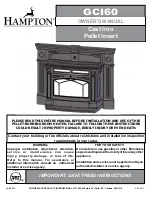
July 13, 2017
20
Keeping a fire
To add wood in the stove and keep a fire:
1) Pull the handle under the apron of the stove
forward and
wait a few seconds to let the fire adjust to the new
conditions.
2) Open the door handle to the previous position and wait
some time so that the fire has time to adjust
3) Turn the door handle completely and leave the door half-
open and let the fire set up.
4) Open the door completely.
5) Move embers near the door with poker to supply it with
oxygen and make it burn completely.
6) Add firewood over the ember, keeping it away from the
glass door to avoid flame touching the ceramic glass.
ATTENTION
DO NOT FILL THE STOVE OVER THE UPPER
BRICK.
DO NOT BUILD A FIRE NEAR THE WINDOW.
THIS APPLIANCE IS DESIGNED TO BURN DRY
CORDWOOD. WE DON’T RECOMMEND ANY OTHER
TYPE OF WOOD.
7) Close the door slightly and let the wood burn.
8) Once the fire gets stable, close and lock the door.
9) Push the air admission knob to the desired condition.
RISK OF OVERHEATING: NEVER LEAVE THE STOVE
UNATTENDED WHEN THE DOOR IS SIGHTLY OPEN.
ALWAYS CLOSE THE DOOR AFTER ADDING A LOAD.
DO NOT USE ANY INFLAMMABLE LIQUID TO REKINDLE
THE FIRE.
Fuel Selection
This stove is designed to burn only firewood. Using firewood
dried properly will result in an higher efficiency and a lower
pollutant’s emission compared with using softwood or fresh
wood.
Moisture Meter Information
Firewood is ready to use at 10
‐
25% moisture content.
Fresh cut logs can have a moisture content of 80% or more,
depending on species. During the drying process, wood might
shrink, split, twist or change shape. In general, wood must be
dried before use. Air drying, i.e. ‘seasoning’ is the most
common method used for cordwood.
Season wood outdoor in summer for at least 6 months before
use. Properly seasoned wood is darker, has cracks at the
ends, and sounds hollow when one piece is smacked against
one another.
In most parts in the North America, the minimum moisture
content that can be generally obtained by air drying is about 12
to 15 percent.
Things not to burn
1) Garbage;
2) Lawn clippings or yard waste;
3) Materials containing rubber;
4) Plastic materials;
5) Waste containing petroleum products, paints or solvent;
6) Materials containing asbestos;
7) Construction or demolition debris;
8) Railroad ties or pressure-treated wood;
9) Manure or animal remains;
10) Salt water driftwood or other previously salt water
saturated materials;
11) Unseasoned wood;
12) Paper products, cardboard, plywood, or particleboard.
The prohibition against burning these materials does not
prohibit the use of fire starters made from paper, cardboard,
saw dust, wax and similar substances. Burning these materials
may result in release of toxic fumes or make the stove
ineffective.
Wood storage
The cordwood must be stored in a dry place, away from bad
weather.
It should not be stored under or near the stove.
If any wood is stored next to the stove, the minimum
clearances must be respected to avoid self-ignition
temperature.
•
48 inches (122 cm) front
•
10 inches (25.4 cm) rear
•
20 inches (50.8 cm) sides
Draft
Draft is the force which moves air from the appliance up
through the chimney. The amount of draft in your chimney
depends on its length, local geography, nearby obstructions
and other factors. Too much draft may cause excessive
temperatures in the appliance and may damage the appliance.
An uncontrollable burn or excessive temperature indicates
excessive draft.
Insufficient draft will cause the appliance to leak smoke into the
room through the appliance and chimney pipe joints.
















































